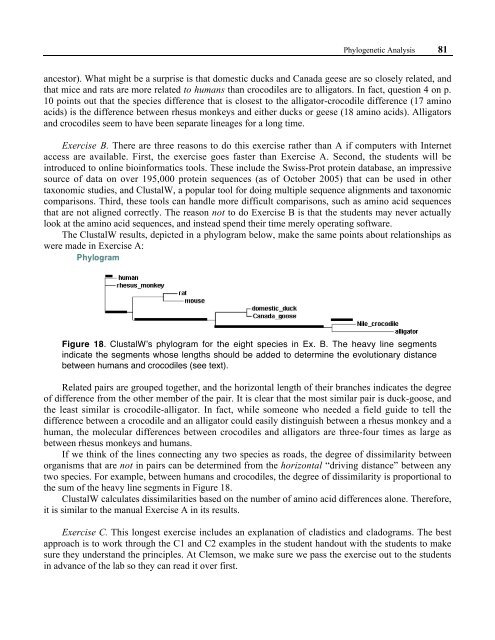An Introduction to Phylogenetic Analysis - Association for Biology ...
An Introduction to Phylogenetic Analysis - Association for Biology ...
An Introduction to Phylogenetic Analysis - Association for Biology ...
You also want an ePaper? Increase the reach of your titles
YUMPU automatically turns print PDFs into web optimized ePapers that Google loves.
<strong>Phylogenetic</strong> <strong>An</strong>alysis 81<br />
ances<strong>to</strong>r). What might be a surprise is that domestic ducks and Canada geese are so closely related, and<br />
that mice and rats are more related <strong>to</strong> humans than crocodiles are <strong>to</strong> alliga<strong>to</strong>rs. In fact, question 4 on p.<br />
10 points out that the species difference that is closest <strong>to</strong> the alliga<strong>to</strong>r-crocodile difference (17 amino<br />
acids) is the difference between rhesus monkeys and either ducks or geese (18 amino acids). Alliga<strong>to</strong>rs<br />
and crocodiles seem <strong>to</strong> have been separate lineages <strong>for</strong> a long time.<br />
Exercise B. There are three reasons <strong>to</strong> do this exercise rather than A if computers with Internet<br />
access are available. First, the exercise goes faster than Exercise A. Second, the students will be<br />
introduced <strong>to</strong> online bioin<strong>for</strong>matics <strong>to</strong>ols. These include the Swiss-Prot protein database, an impressive<br />
source of data on over 195,000 protein sequences (as of Oc<strong>to</strong>ber 2005) that can be used in other<br />
taxonomic studies, and ClustalW, a popular <strong>to</strong>ol <strong>for</strong> doing multiple sequence alignments and taxonomic<br />
comparisons. Third, these <strong>to</strong>ols can handle more difficult comparisons, such as amino acid sequences<br />
that are not aligned correctly. The reason not <strong>to</strong> do Exercise B is that the students may never actually<br />
look at the amino acid sequences, and instead spend their time merely operating software.<br />
The ClustalW results, depicted in a phylogram below, make the same points about relationships as<br />
were made in Exercise A:<br />
Figure 18. ClustalW’s phylogram <strong>for</strong> the eight species in Ex. B. The heavy line segments<br />
indicate the segments whose lengths should be added <strong>to</strong> determine the evolutionary distance<br />
between humans and crocodiles (see text).<br />
Related pairs are grouped <strong>to</strong>gether, and the horizontal length of their branches indicates the degree<br />
of difference from the other member of the pair. It is clear that the most similar pair is duck-goose, and<br />
the least similar is crocodile-alliga<strong>to</strong>r. In fact, while someone who needed a field guide <strong>to</strong> tell the<br />
difference between a crocodile and an alliga<strong>to</strong>r could easily distinguish between a rhesus monkey and a<br />
human, the molecular differences between crocodiles and alliga<strong>to</strong>rs are three-four times as large as<br />
between rhesus monkeys and humans.<br />
If we think of the lines connecting any two species as roads, the degree of dissimilarity between<br />
organisms that are not in pairs can be determined from the horizontal “driving distance” between any<br />
two species. For example, between humans and crocodiles, the degree of dissimilarity is proportional <strong>to</strong><br />
the sum of the heavy line segments in Figure 18.<br />
ClustalW calculates dissimilarities based on the number of amino acid differences alone. There<strong>for</strong>e,<br />
it is similar <strong>to</strong> the manual Exercise A in its results.<br />
Exercise C. This longest exercise includes an explanation of cladistics and cladograms. The best<br />
approach is <strong>to</strong> work through the C1 and C2 examples in the student handout with the students <strong>to</strong> make<br />
sure they understand the principles. At Clemson, we make sure we pass the exercise out <strong>to</strong> the students<br />
in advance of the lab so they can read it over first.
















